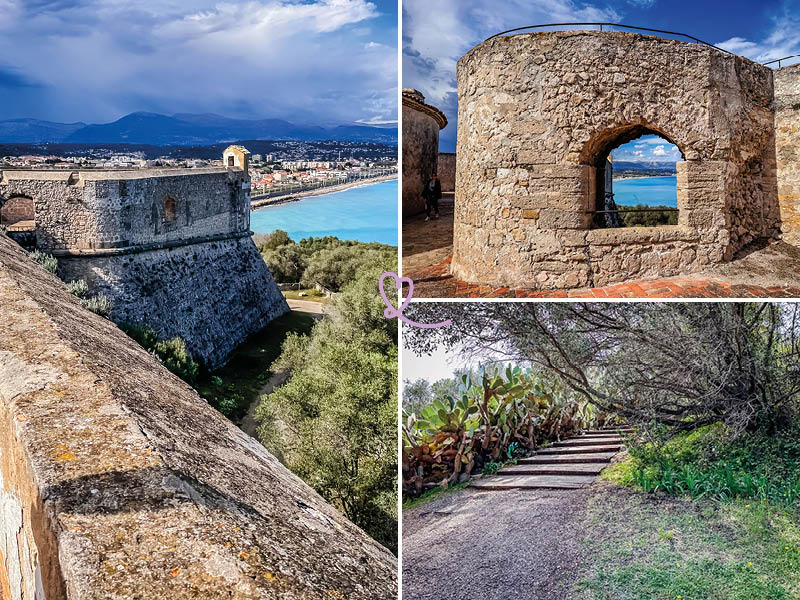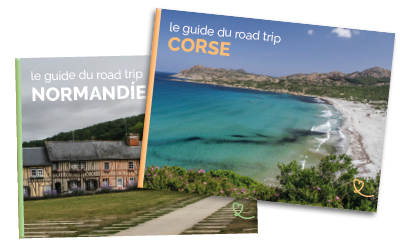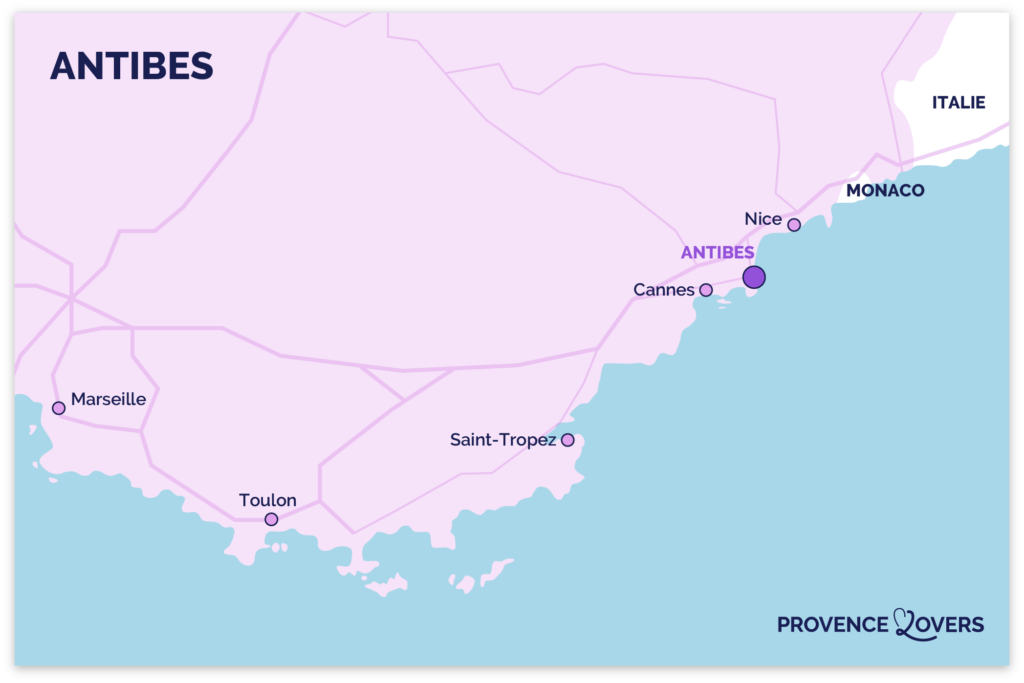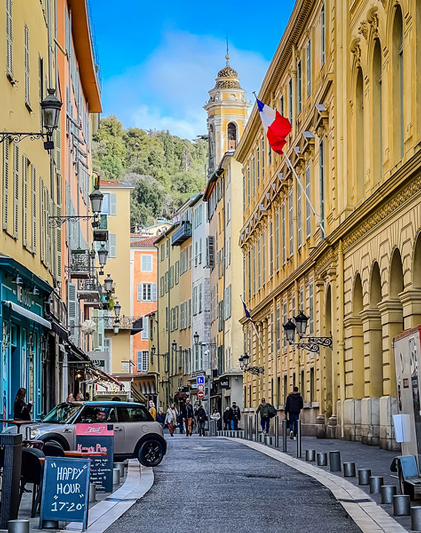A landmark of Antibes, this imposing and singular fort is a must-see. Located on the Saint-Roch peninsula, it overlooks the surrounding area from its rocky spur rising 26 meters above sea level. This strategic position enabled it to protect French borders during the Renaissance. We recommend a visit to Fort Carré, which offers superb panoramic views of the region. Architecture fans will be delighted to discover this architectural masterpiece in the shape of a 4-pointed star!
In this article, we give you all our advice on how to discover this military fort with its fascinating history.

This guide is completely independent, based on our experiences. We visited the region anonymously, making our own choices and paying our bills in full.
Why visit Fort d’Antibes?
Is Fort Carré worth it? Our review
Absolutely! We recommend that you visit Fort Carré during your stay, because it’s both majestic and interesting. In fact, it features in our selection of must-do activities in Antibes. We enjoyed the visit, which began with a tour of the unspoilt park, where the pathway provides a better understanding of the Mediterranean flora and fauna. The interior of the fort, in particular the covered walkway, offers magnificent views of the coast and Old Antibes, making it an ideal first approach to the town.

Why is the Fort Carré in Antibes famous?
Located next to Port Vauban, it is known as one of the first bastioned forts built during the Renaissance. It dates back to the 16th century, when Henri II, King of France, needed a sentry to watch over the border with the Duchy of Savoy, then occupying the County of Nice. It is also famous for the many inscriptions left by soldiers. They resided there when the fort became a high-level military sports training center after the Second World War. Finally, he was immortalized in the James Bond saga with the film Jamais plus Jamais (1983).
It’s one of the most interesting forts on the Côte d’Azur.

What we liked best
Our choices are subjective, but we’d still like to share our 3 favorite moments from our visit:
- Panoramic views from the chemin de ronde: the chemin de ronde takes you around the monument and its 4 bastions, offering spectacular views of Old Antibes, Nice and the hinterland.
- The discovery of military graffiti: we found it moving to read the inscriptions left by the military, particularly present on the bastions.
- La Chapelle Saint-Jean: we weren’t expecting to enter such a lovely chapel on our visit. Yet it retains a remarkable polychrome decoration.

A LITTLE MORE patience
All the photos, maps, information, good addresses to make your stay in Provence a success, will soon be gathered in a single ebook!
If you wish to be informed of the publication of our guide on Provence, subscribe:

History in brief
Fort Carré was built from 1553 onwards by order of King Henri II of France, son of François I. Its aim was to build an effective defensive system in the eastern part of Provence, to protect the Kingdom of France during the Italian Wars (1494-1559). However, the fort was not completed until 1585. At the time, it acted as a surveillance post and deterrent to the County of Nice, then part of the Duchy of Savoy. This did not prevent Charles Emmanuel I of Savoy from laying siege to the fort and Antibes during the Wars of Religion. Taken over by the French, the fort endured a second siege during the War of the Austrian Succession, but held firm, no doubt thanks to its architecture.

Little is known about the fort’s architect. It is attributed to Jean de Renaud, a military engineer from Saint-Rémy-de-Provence. We’ll be taking a closer look at the details of its architecture, based on the art of mathematics.

Under Louis XIV, Vauban considered improvements to the fort, but most of his work was never completed. When Nice became part of France in 1860, the fort became obsolete. It was attached to the army, briefly occupied by soldiers during the First World War, before being used as a foreigners’ assembly center during the Second World War. Transformed into a training site for various military sports schools, then into a regional physical education center, it was restored by a volunteer association in 1979, then purchased by the commune in 1997. Opened to the public the following year, it was classified as a historic monument in 1906.

WHERE TO STAY IN Antibes
Option 1: near the ramparts
Close to the ramparts, to enjoy the charm of the old town and all the restaurants.
Hôtel la Villa Port – See prices, photos and availability
On the beach side (Ponteil and Salis) with views of the ramparts and mountains.
Hôtel La Jabotte – See prices, photos and availability
In Juan-les-Pins, in the heart of the peninsula.
Hôtel La Villa Cap d’Antibes – See prices, photos and availability

Practical tips and map: Fort Carré, Antibes, France.
Where is the fort?
The fort is located at the following address: Avenue du 11 Novembre, 06600 Antibes. It is located at the entrance to the commune, along the railroad line, next to Port Vauban and Plage du Fort Carré.
Here’s a map of the region to help you find your way:

- Driving time from Cannes: 30min.
- Driving time from Nice: 40min.
- Driving time from Monaco: 50min.
- Driving time from Marseille: 2h15.
How to get there
You have several options for accessing Fort Carré:
- How to get there by car: The fort is easy to find and well signposted. On the other hand, the narrow streets of Old Antibes can be difficult to navigate and park in. There can be traffic jams, especially during the summer season. Allow 10min from the city center and from the seaside resort of Juan-les-Pins.
- On foot: a 30-minute walk from Old Antibes.
- By shuttle bus: a free shuttle bus runs between the old town and the Fort Carré parking lot every 10 minutes. We highly recommend this solution, as it’s the easiest!
- By bus: Antibes has a significant bus network linking it to the surrounding towns (Cannes, Biot, Vallauris…). The nearest stops are Porte Marine and Fort Carré, served by line 14. We invite you to plan your itinerary on the official website of the agglomeration’s transport network, here.

OUR TPS FOR RENTING YOUR CAR IN Provence
- Compare prices on our preferred platform: DiscoverCars – one of the best rated sites.
- Choose a car that is powerful enough (the roads are steep) but compact (some passages are narrow).
- Think of thecomplete insurance (some roads are tortuous and narrow).
- There is a lot of demand, book it early.

Parking
The Fort Carré parking lot is a 10-minute walk from the monument. It is free and has 150 seats. Campers and caravans are prohibited.

Schedules and rates
Reservations are recommended by telephone on +33 (0)4 92 90 52 13.
Schedules:
- June 15 to September 15: open daily (except Mondays) from 10am to 6pm.
- September 16 to June 14: open daily (except Mondays) from 10am to 5pm.
- Closed on January 1, May 1, November 1, December 25 and in bad weather.
- Last visit 30min before closing time.
Ticket price:
- Full adult price: €3,
- Reduced rate: €1.50,
- Free admission for under-18s, jobseekers…
- Included in the Pass’Musées d’Antibes Juan-les-Pins, allowing you to discover all the municipal museums for €10.
We invite you to consult the official website for full pricing conditions here.

Best time to visit Fort d’Antibes
Fort Carré is a landmark in Antibes. Its renown can lead to heavy traffic, especially on weekend afternoons. If you can, we advise you to go during the week, preferably outside the school year. If you’re an early riser, we recommend you get there as soon as it opens! Before your visit, be sure to check the weather forecast, as the monument may be closed in bad weather.

Visit duration and practical information
Allow 1 to 2 hours for your visit, depending on your interest in the history of the site and the panoramic views. The access road to the fort, in the park, is slightly stony, with a few climbs. Inside, there are many narrow staircases and the floor is bumpy. It is therefore difficult to access for people with reduced mobility, and inaccessible to wheelchair users. However, special visiting facilities are available for the hearing, mentally and visually impaired. To find out more, visit the official website here.

Advice on how to visit
We recommend you start your visit in the protected 4-hectare park, where the access road to the monument is located. Take time to admire the panoramic views and read the information panels on local flora and fauna along the way. You will then enter the fort. You’ll discover the Chapelle and Tour Saint-Laurent, then climb one level to reach the artillery terraces. You’ll need to take a new staircase to explore the covered walkway.

Guided tours
Guided tours are available on a regular basis. They allow you to discover more about the fort’s history, sometimes from different thematic angles. There are also workshops for adults. To find out more, visit the agenda on the official websitehere.

Fort Carré with children
Fort Carré is an ideal family visit. Games and game-books on the history of the fort, or more specifically on the inscriptions left by the soldiers, are available here. Family and children’s workshops are organized on a regular basis. Visit the official website here to find out more.

Nearby restaurants
Antibes boasts many fine restaurants. Here are our 3 favorites, which you can find in our article on the best restaurants to eat in Antibes:
- Restaurant Le Figuier de Saint-Esprit: this Michelin-starred restaurant offers an enchanting setting with its shaded terrace and string lights.
- Restaurant L’Arazur: we were won over by its refined, seasonal cuisine, served in a beautiful vaulted cellar.
- Healthy Lounge Restaurant: we really enjoyed this tasty and colourful healthy restaurant!

HAVE FUN WITH THESE activities
- Great kayak trips in:
Saint-Tropez to the Ramatuelle reserve
Cassis to the calanques - Helicopter flight from Cannes
- Shuttle service along the coast between Nice and Saint-Tropez
- Bike tours: eBike in Nice – Mountain biking in the Esterel massif

The natural site of Fort Carré
Panoramic views
The Fort Carré site is located on the Saint-Roch peninsula. It comprises a 4-hectare natural area protected by the Conservatoire du Littoral. The access road to the fort is located in this park. We loved the panoramic views of Nice and the Mercantour Massif in the background.

To help you find your way around, we recommend you use the orientation table along the way. We learned a lot about the landscapes visible from the Fort Carré site. For example, we distinguish between those that have retained their original appearance (Mont Gelas, Massif du Mercantour…) and those that have been profoundly transformed by human activity, such as the Vallée des Merveilles, much visited for its prehistoric remains. We were also interested in the presentations of the region’s woodlands and valley mouths. Don’t hesitate to take the side trails to make the most of the views.

Discovering flora and fauna
A tour of the park highlights the rich biodiversity of this natural area. First of all, we were able to learn more about its typically Mediterranean flora, thanks to an explanatory terminal we found on the main trail. An inventory of the species present on the site is presented, along with its main characteristics. For example, the vegetation on its cliffs is made up of limonium, which blooms in summer with hues between blue and violet, and euphorbia, perennials with regular leaves.

As you progress, you’ll also come across wooded areas with holm oak, carob and olive trees.

This natural area is also home to a rich fauna including hedgehogs, squirrels, red foxes and reptiles. There are indeed lizards and garter snakes, but don’t worry, we didn’t come across any! On the other hand, you’re likely to see a wide variety of birds, just as we do. A signpost indicates the park’s main species (nightingales, turtle-doves, etc.).

Historical heritage
The site boasts a significant historical heritage, not to mention the fort itself. Don’t miss Henri Bouchard’s monumental statue of the “Poilu”, nearly 22 meters high. It pays tribute to the 261 soldiers from Antibes who fell in the First World War. You can see it from the fort, or before entering the site, along the stadium. Take a stroll around the fort, or from the parapet walk, and you’ll also see the tomb of General Championnet. This hero of the Revolution founded the Parthenopean Republic in Naples, before dying in Antibes in 1800.

Subscribe to our Newsletter
- Get away from it all with Region Lovers’ beautiful destinations!
- Once a month
- Advertising-free
Attacking the fort
The Saint-Laurent Tower and Chapel
We began our visit by discovering the very first construction of the fort, the round tower of Saint-Laurent. The heart of the monument, it was built on the site of a chapel of the same name, which was destroyed before work could begin. This central tower is part of a square, from which four particularly slender bastions extend, which we’ll discover later in the tour. Right next to the Saint-Laurent tower, we were able to enter the chapel of the same name, which pleasantly surprised us!

We didn’t expect to admire the superb polychrome decorations when we visited the fort. Yet that’s what characterizes this chapel, built in 1704 and named after the one destroyed in the 16th century. When you’re inside, keep your eyes peeled! There are inscriptions, and even a boat engraved on one of the painted walls! This building was used by soldiers as a place of meditation, and hosted the wedding of a commander’s daughter in 1771, to thank him for his services. Then continue your visit by climbing to the upper level. There’s also a mezzanine floor that used to house the soldiers’ bedrooms, but is unfortunately closed to the public.

The artillery terraces and Maison du Gouverneur
The next level took us back into the fort’s history, reminding us of its role in defending the frontier of the Kingdom of France. In fact, this floor is made up of artillery terraces, where soldiers handled the cannons. There are numerous embrasures, also known as “bouches à feu”, where cannons were placed. Today, we’re making the most of these openings for their views over Nice and the Mediterranean, which we found sublime!

We were able to observe the artillery store, where ammunition was stored. Inside, we once again find graffiti left by the military, including a woman’s head. Can you find it?

The Maison du Gouverneur is also located on this level. It was home to two officers, but also served as a prison for one. To get a better idea of its size and location within the fort, we recommend that you go up one floor to continue your visit!

The parapet walk and its bastions
You’re now on the walkway. This is undoubtedly our favorite part of the visit. In our opinion, it’s also the best place to understand the monument’s architecture. From this level, you can see all the buildings that make up the fort (the Saint-Laurent tower, the Governor’s House, the artillery store…). The tour takes in its 4 bastions, named after their respective directions: Corsica, Nice, France and Antibes.

We start with the Corsican bastion, then move on to the Nice bastion. We particularly appreciated the splendid panoramic view from this bastion, where you could admire Nice and the peaks of the Mercantour Massif. Then, from the France bastion, we took in the view of the hinterland.

Finally, the walkway ends at the Antibes bastion, which gave us another view of the town. In addition to the Vauban port and the old town, we were able to catch a glimpse of Cap d’Antibes and the Bois de la Garoupe. Don’t miss the military inscriptions on this bastion. In general, you can read the names of the soldiers, and the date of their class, i.e. their date of admission to the army.

As you leave, take time to observe the fort’s massive entrance gate and its ingenious pulley system!






